Abstract
Hypertension is a major public health problem of this era. Hypertension related morbidity and mortality rates have dramatically increased over the last 25 years. Stressful life style is one of the leading causes of Hypertension. The treatment of hypertension remains a primary goal in the effort to reduce morbidity and mortality from cardiovascular disease, stroke and kidney disease. In this study, 20 patients were randomly divided in two groups and treated along with restricted diet pattern for 8 weeks. Patients of Group A received poly-herbal compound formulation Shankhapushpyadi Ghana Vati (2gm/day). It was found that, relief in overall symptoms (63.93%) elevated blood pressure (8.91% in Systolic blood pressure and 8.44% in diastolic blood pressure). In group-B, with Sarpagandhadi Ghana Vati (2gm/day) the percent relief was better on elevated blood pressure (12.00% in Systolic blood pressure and 11.02% in diastolic blood pressure). When data is subjected in between both the groups, it is found that, both drugs are equally effective.
Keywords: Diastolic blood pressure, essential hypertension, Shankhapushpyadi Ghana Vati, Sarpagandhadi Ghana Vati, systolic blood pressure
Introduction
Ayurvedic texts provide no straight reference about essential hypertension, but disease can be explained on the base of Ayurvedic principles.
A number of conceptual studies have been conducted to develop the correlates of hypertension in Ayurveda. Gananath Sen has merely substituted high blood pressure with a new word Dhamini Prapurnata. Dhamini Pratichaya is defined as Dhamini Upalepa[1] by Chakrapani. Certain scholars have attempted to correlate hypertension with Raktagata Vata, Vyana Bala Vikruti, etc. The term ‘hypertension’ was coined after the invention of sphygmomanometer but before that about its existence, one can trace the pathway on the tract of symptomatology. Different views have been adopted but no one has denied the fact that hypertension, is result of Rakta Dushti with Tridosha involvement in which Vata and Pitta Dosha are prominent. As it is considered as psychosomatic disease, Mana also involved in pathology of this disease. Symptoms of essential hypertension can be understood on the base of Ayurvedic concepts as:
Shiroruka (Headache)
Throbbing pain chiefly in the occipital region usually during early morning.[2] It is suggested due to raised intracranial pressure. Involvement of Rakta Dhatu[3] and Vata Dosha[4] is considered in all Shiroroga.
Bhrama (Giddiness)
It can be compared with whirling sensation. It may due to vitiation of Raja Dosha along with Vata and Pitta Dosha.[5]
Hriddravatva (Palpitation)
Increased viscosity of Rasa Dhatu due to Ama formation leads to improper functioning of Vyana Vata. Palpitation is considered in Nanatamaj Vata Vyadhi by Aacharya charaka.[6]
Aayasajanya Swasa Kashtata (Dyspnea)
Elevated pulmonary capillary pressure increases fluid transudation in to pulmonary interstitium. When Pranavaha Srotas gets obstructed due to vitiated Kapha, the Patha of Vata become obstructed and Swasakashtata gets manifested.
Anidra (Disturbed sleep/Insomnia)
When Mana is not able to retract itself from its object Nidranasha gets manifested, which is a Nanatmaja Vata Vyadhi.[7]
Urahashoola (Chest pain)
All kinds of pain is due to Vata Dosha.[8] Ama produced due to Agnimandhya also obstructs the supply of nutrition to myocardium and produces pain.
Daurbalya (Weakness)
Reduced capillary pressure results improper perfusion of tissue. Ojakshaya and Srotovarodha due to Ama produce impaired nourishment of Uttarottara Dhatu.
Tamodarshana (Flashes before eye)
It will manifest due to transient cerebral ischemia[9] in advance stage of disease. Sroto Avrodha in Raktavahini results this condition of Tamodarshana. Tamodarshana is also considered in Rakta Pradoshaja Vikara by Aacharya Charaka.[10]
Buddhi samoha (Lack of concentration and decision)
This is result of Vitation of Chala Guna of Vayu, and Sadhaka Pitta and Mano Dushti due to Raja and Tama Guna.
Krodha prachuryata (Mental irritability)
Krodha is expression of Pitta Dosha vitiation.
Vibandha (Constipation)
Vitated Vata Dosha causes Vishamaagni and produces Vigunata of Apana Vayu.
Pada Shotha (Pedal edema)
Vitated Kapha, Pitta and Rasa, Rakta Dhatu get seated in peripheral vessels and obstruct the path of Vata and thus produce Shotha.
Smrutinasha (Forgetfulness)
Sadhaka Pitta and Mana are responsible for memory. Manodushti and Pitta vitiation cause Smrutihrasha.
Aruchi (Anorexia)
Psychological factor and Ama production may be responsible for this condition. Psychological factors like grief, etc., are also responsible for this condition of Aruchi.[11]
Akshiraaga (Redness of eye)
Vitiation of Pitta Dosha and Rakta Dushti results in Akshiraaga, i.e.; hyperemia of conjunctiva or subconjuctiva.
Klama (Fatigue)
Fatigue is due to combined effect of vasoconstriction and impaired cardiac output. Vitiation of Vata (movement) and Kapha (Bala) may be responsible.
All the above-mentioned features show dominance of Vata and Pitta. In given pathology, Vyana Vayu, Sadhaka Pitta, Avalambaka Kapha are chiefly involved. Psychological problems associated with essential hypertension are treated with long-term use of sedative and anxiolytic drugs which may lead to hazardous effects on mental health and produce drowsiness, impaired motor functions, loss of memory, nonsocial behavior, etc. Moreover these drugs produce drug dependency and drug resistance. Therefore, it is need of time to think from Ayurvedic point of view for the better management of mental health and efforts to reduce morbidity and mortality from cardiovascular disease, stroke, and kidney disease due to advanced stages of disease.
Considering this Shankhapushpyadi Ghana Vati (Anubhoot Yoga) was formulated which contain Ayurvedic drug Shankhapushpi (Convolvulus pluricaulis)- 1½ Part, Brahmi (Bacopa monnieri)- 1½ Part, Guduchi (Tinospora cordifolia)- 1 Part, Aaragvadha (Cassia fistula)- 1 Part, Nimba (Azadirachta indica)- 1 Part, Kushtha (Saussurea lappa)- 1 Part, Vacha (Acorus calamus)- ¼ Part, Gokshura (Tribulus terrestris)- ¾ part. In group B, Sarpagandhadi Ghana Vati (Containing Sarpagandha, Jatamansi, Parseekyavani, Pippalimool) mentioned by Aacharya Yadavaji Trikamaji in Siddha Yoga Sangraha was selected for comparative study with some modification. As Bhanga is socially not ethical to given because of its delirient action, so excluded out from above combination. Considering all these points, the present study was planned with the aim to compare the effect of Shankhapushpyadi Ghana Vati and Sarpagandhadi Ghana Vati in the management of essential hypertension.
Materials and Methods
Study design: It is a randomized single blind controlled study. The data obtained after clinical study was analyzed with the help of paired ‘t’ test
-
Selection of cases: The study was carried out in 20 clinically diagnosed patients of essential hypertension, selected from the OPD and IPD of Govt. Akhandanand Ayurveda College and Hospital, Ahmedabad, as per the selection criteria. Of the 20 patients, no patient was dropped out during the trial period. The cases were randomly selected irrespective of their sex, occupation, socioeconomic status. These patients were randomly divided into two groups.
- Patients of Group A were treated with Shankhapushpyadi Ghana Vati (2 g/day in divided doses, along with restricted diet pattern for 8 weeks)
- Patients of Group B were treated with the Sarpagandhadi Ghana Vati (2 g/day in divided doses, along with restricted diet pattern for 8 weeks.).
Follow up was done on every seventh day up to 6 weeks after completion of the therapy in all the patients.
Criteria of diagnosis
Patient having elevated Blood pressure with clinical symptoms as stated in modern medicine.

Exclusion criteria
Irregular and complicated patients with diabetes mellitus, cardiovascular diseases, asthma, renal diseases, severe grade of hypertension [systolic≥180, or diastolic≥110 mmHg], other controversies should be excluded from study.
Investigation
Blood - Routine hematology investigation, lipid profile, blood urea, serum creatinine (if necessary and possible), CPK-MB. (if necessary and possible).
Urine - Routine and microscopic examination.
ECG and X-ray (if necessary and possible).
These investigations were conducted to exclude any other underlying pathology.
Drug, dose and duration
The patients were treated with Shankhapushpyadi Ghana Vati and Sarpagandhadi Ghana Vati administered in 1 g dose twice a day and duration of treatment was 60 days.
Assessment of effect of therapy
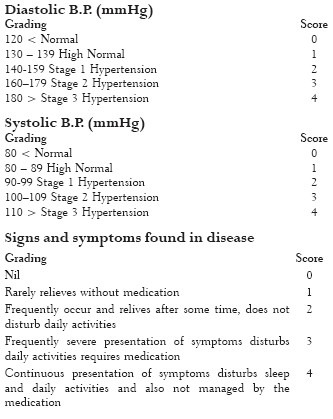
Assessment on basis of complaints:
Controlled 100% relief in complaints
Marked relief ≥ 75% relief in complaints
Moderate relief ≥ 50–74% relief in complaints
Mild relief ≥ 25-49% relief in complaints
No relief <25% relief in complaints
Assessment on basis of systolic and diastolic blood pressure level
Controlled Patients having blood pressure levels within normal limit.
Marked relief Blood pressure level improved by ≥ 75% than before treatment
Moderate relief Blood pressure level improved by ≥ 50-74% than before treatment
Mild relief Blood pressure level improved by ≥25-49% than before treatment
No relief Blood pressure level not improved or improved by< 25% than before treatment
Follow-up study
After completion of 2 months course of therapies, the patients were advised to report weekly up to 6 weeks. During these visit, improvement or deterioration or no change in the signs and symptoms were recorded.
Observations and Results
Maximum patients i.e.; 60% were in the age group of 51-60 years. Fifty-five percent were male, 40% were housewives, and 95% were married, 75% were Hindu, 35% were belonging to upper middle class of the society and 60% nonvegetarian.
Effect of therapies: Twenty patients were selected in the present study, 10 patients in each group. The efficacy of each therapy was adjudging on varied parameters and the results were derived after execution of statistical methodology. The data regarding effect of therapies on systolic and diastolic blood pressure of individual patients of both groups is provided in Table 1.
Table 1.
Effect on systolic and diastolic blood pressure (mmHg) of group A and group B

In group A, 10 patients had completed the treatment with highly significant relief in: Shiroruka- Headache (84.61%), Bhrama- Giddiness (75%), Alpanidra- Insomnia (69.56%), Daurbalya- Weakness (56.67%), Klama- Fatigue (51.85%), Buddhisammoha- lack concentration and decision power (78.26%), Krodhaprachuryata-Mental irritability (78.57%), Malavarodha- Constipation (74.07%), Smrutihrasha- Forgetfulness (84%), Aruchi- Anorexia (91.66%), in Hriddravatva-Palpitation (66.67%), Aayaasjanyaswasakashtata– Dyspnea (52.94%), Arati- Uneasiness (57.14%), Santapa -Feeling of tension (54.54%), Akshiraaga -Redness of eyes (54.54%), and significant relief Urahashoola -Chest pain (80%), Tamodarshana -Flashing before eyes (33.33%), Pada Shotha-Pedal edema (71.42%) [Table 2].
Table 2.
Effect on chief and associated complaints of group A
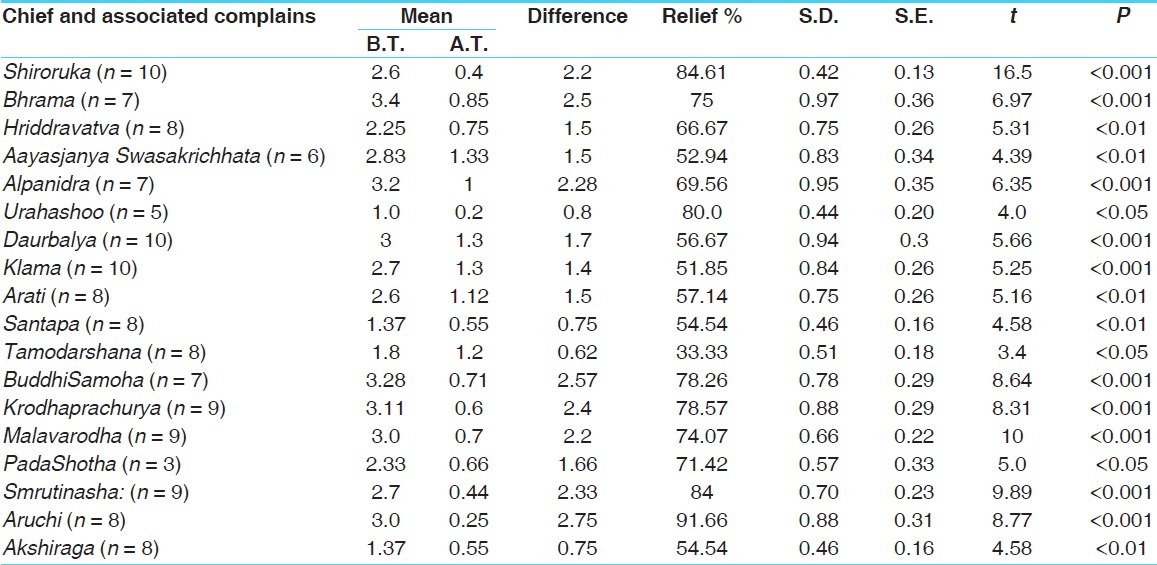
In group B, 10 patients had completed therapy with highly significant improvement on: Shiroruka (85%), Bhrama (70.96%), Aayaasjanyaswasakashtata (68.75%%), Alpanidra (75%), Urahashoola (75%), Daurbalya (54.54%), Klama (51.51%), Tamodarshana (76.92%), Krodhaprachuryata (57.14%), Malavarodha (58.33%), Smrutihrasha (69.56%), Arati (52.38), Aruchi (77.77%), Buddhi Samoha (69.23%), significant relief in Hriddravatva (40%), Santapa (40%), Pada-Shotha (60%), Akshiraaga (50%) [Table 3]. Relief in high blood pressure was observed in 8.91% and 8.44% in systolic and diastolic blood pressure, respectively, treated with Shankhapushpyadi Ghana Vati whereas by Sarpagandhadi Ghana Vati, better relief was obtained i.e.; 12.00% and 11.02% relief in systolic and diastolic blood pressure, respectively [Table 4]. Both drugs, showed highly significant relief in systolic as well as diastolic blood pressure. Significant relief in pulse pressure were observed in both Group A (8.36%) and Group B (14.74%), while mean arterial blood pressure showed highly significant result in both Group A (8.41%), and Group B (12.43%).
Table 3.
Effect on chief and associated complaints of group B
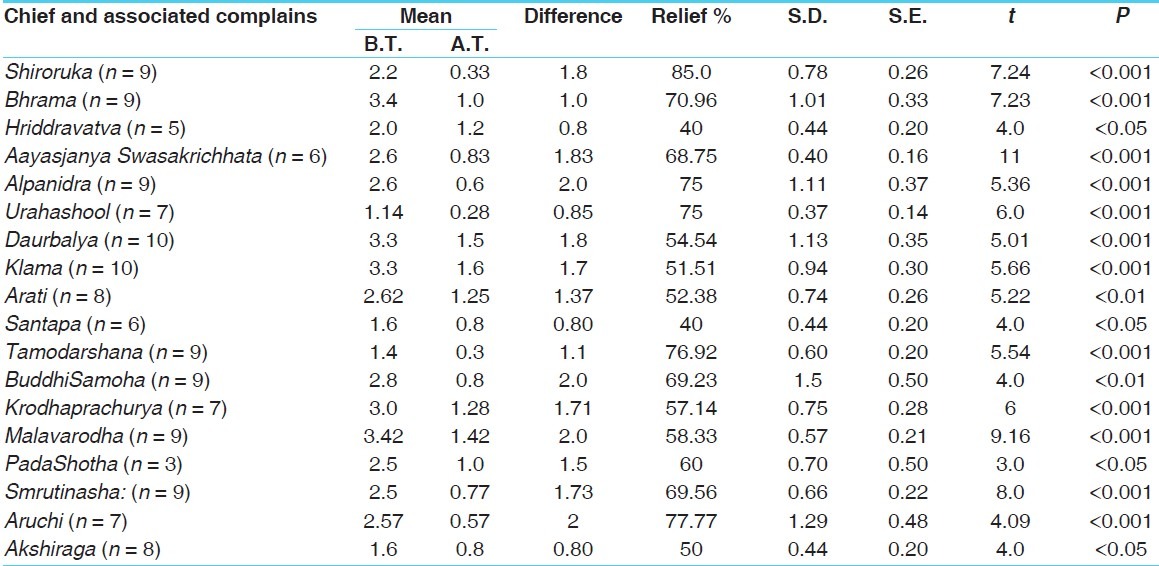
Table 4.
Effect of therapies on systolic and diastolic blood pressure before and after treatment

On hematological investigations, hemoglobin of therapeutic groups was insignificantly increased by Shankhapushpyadi Ghana Vati (4.88%) and insignificant decreased by Sarpagandhadi Ghana Vati (1.68%) and erythrocyte sedimentation rate (ESR) was also reduced by Shankhapushpyadi Ghana Vati (41.6%) and improved by Sarpagandhadi Ghana Vati (30.02%).
Changes in lipid profile, in group A, Vati serum cholesterol (14.93%) and in group B, serum cholesterol (10.31%) were found insignificant.
On renal profile, blood urea (13.23%) were decreased in group-A, and in group-B, (3.96%). The result was statistically insignificant.
On biochemical parameters, postprandial urine sugar (0.20%) was increased and fasting blood sugar (4.64%) was reduced in group A whereas in group B, fasting blood sugar (1.64%) and postprandial blood sugar (3.1%) were decreased and the result was statistically insignificant.
Analyzing the overall effect of therapy, in sign and symptoms of disease, 30% patients were markedly improved, 60% were moderately improved, 10% were mild improved and none patient observed in no response category in Group A, whereas in group B, 20% patients were markedly improved, 80% moderately improved [Table 5].
Table 5.
Estimation of overall response on chief and associated complains of each Group
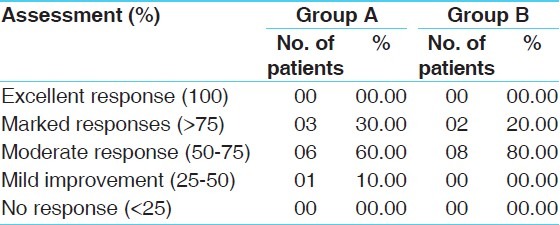
Overall effect of therapy, in systolic and diastolic blood pressure, 40% and 70% patients were markedly improved, 40% and 10% were moderately improved, 20% and 20% were mild improved respectively, in Group A, whereas in Group B, 60% and 50% patients were markedly improved, 40% and 30% moderately improved, respectively [Tables 6,7].
Table 6.
Estimation of overall response on systolic blood pressure of each group
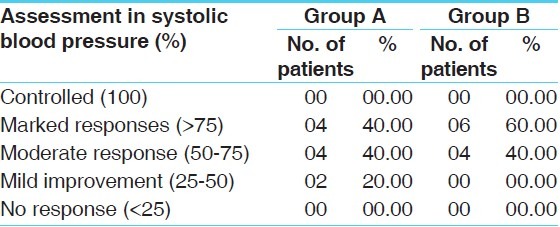
Table 7.
Estimation of overall response on diastolic blood pressure of each group
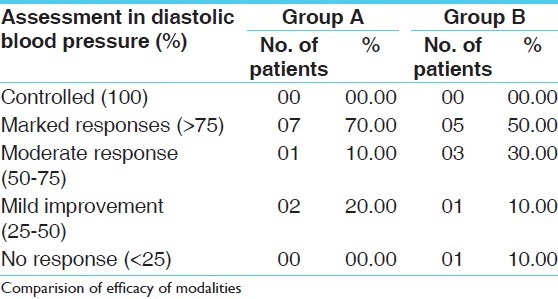
Discussion
Although there is no difficulty in understanding the disease of hypertension from modern point of view there is some difficulty in identifying the disease entity of Ayurveda. The Adhishthana (seat) of hypertension is whole body and Mana, particularly Hridaya (heart) and Sira-Dhamani (blood vessels), which indicates Essential Hypertension (EHT) is a psychosomatic disease. As stated by Aacharya Charaka, physician should try to understand the nature of the disease (Dosha), the site of manifestation and etiological factors and then initiate the treatment. There is no need to give a definite name to each and every disease. Thus in case of hypertension, it is essential to understand the nature of the disease rather than to give name. Therefore, depending upon the symptoms, Samprapti (pathogenesis) and complication of the disease a compound preparation named as Shankhapushpyadi Ghana Vati (Anubhoota Yoga) was formulated to provide a cost effective and safe remedy as compared to Sarpagandhadi Ghana Vati.[12]
Probable mode of action of Shankhapushpyadi Ghana Vati
It is potent herbs like Shankhapushpi (Rasayana and Medhya),[13] Brahmi (Rasayana and Medhya),[14] Guduchi (Rasayana and Medhya),[15] Aaragvadha (Hridya and Mriduvirechaka),[16] Nimba (Raktashodhaka),[17] Kushtha,[18] Vacha (Sleshmaupshoshaka and Lekhana),[19] Gokshura (Rasayana and Mutrala).[20]
The trial drug is able to correct provoked Dosha, vitiated Dushya, hampered Agni and affected Srotas (channels) involved in the pathophysiology of essential hypertension by its potent ingredients.
Rasayana property of Shankhapushpi, Brahmi, Guduchi and Gokshura check degenerative changes in affected organ (as arteriosclerosis in Dhamani or vessels) due to pathological changes and also provide nourishment at cellular level. Medhya property of Shankhapushpi, Brahmi, and Guduchi calms the mind and maintain equilibrium of autonomous nervous system which acts on vasomotor canter which creates vasodilatation and may helpful to decrease the blood pressure. Sangyasthapaka property of Vacha and Kushtha may also maintain equilibrium of autonomous nervous system. Bastishodhaka and Rasayana property of Gokshura acts as diuretic and also regulate renin angiotensin pathway. Mridu Rechaka, property of Aaragvadha purify Rakta Dushti and removes Margavarodha and eliminates the morbid Doshas from Rakta, and regulates the proper function of Vata. Action of Gokshura as diuretic and Aragvadha as Mriduvirechaka may helpful to decrease blood volume which decrease blood pressure.
Shankhapushpi with its Snigdha Guna, Tikta, Kashaya Rasa, Madhura Vipaka decrease excess Vata and Pitta and dominant Dushya-Rakta. Brahmi with its Tikta Rasa and Ushna Virya reduces increased Meda, Kapha and pacify Vata. Guduchi with its Tikta, Kashaya Rasa, Ushna Virya declines Ama and Srotorodha. Aragvadha with its Madhura Rasa and Madhura Vipaka may control the aggravation of Vata while Shita virya may pacify Pitta Prakopa. Owing to its Recaka property it eliminates Koshtha gata Kapha and Pitta. Nimba with its Tikta-Kashaya Rasa and Sheeta Virya property diminishes excessive Pitta and Rakta (Raktashodhaka property). Kushtha with its Katu Rasa and Ushna Virya of drug helpful in checking Vata, It becomes beneficial in symptomatic hypertensive patient having exertional dyspnea due to saussurine alkaloid. Katu-Tikta Rasa and Laghu- Tikshna property of Vacha decreases not only Ama and Kapha but also improves atherosclerotic changes. Gokshura having Madhura Rasa and Madhura Vipaka, Snigdha and Guru Guna may reduce hyperactivity of Vata. The Rasayana effect of Shankhapushpi, Brahmi, Guduchi, Gokshura, improves all Dhatus and provide relief in Dhatukshayatva and Ojoskshayatva of disease by giving nourishing effect on cellular level. The Medhya effect of Shankhpushpi, Brahmi, Guduchi and Vacha (Sangyasthapaka) pacifies the disturbed Manasika Bhavas gives calm the mind and relaxed the entire pathology as having Medhya property also hence significant relief was obtained by Shankhapushpyadi Ghana Vati. Hypertension being a psychosomatic disease, both Sharirika and Manasika Dosha are vitiated and they affect each other mutually as sorrow and fear provoke Vata and anger provoke Pitta. Medhya drug calms the mind and normalizes vitiated Manasa Dosha, which subsequently improves vitiation of Sharirika Dosha and related symptoms. Therefore, therapy Shankhapushpyadi Ghana Vati provided relief in symptoms of hypertensive patients.
Probable mode of action of Sarpagandhadi Ghana Vati
Prominent Rasa of Sarpagandhadi Ghana Vati is Tikta, which will it act on Rasa, Rakta Dhatu along with their Srotas. It reduces the Ama and there by viscosity of Rasa decreases which results proper Rasa Rakta Vikshepana. Rakta Shodhaka property of Tikta Rasa makes equilibrium of substances of Rakta by removing the toxic material those responsible for with pathogenesis of disease. Ushna Virya results Vatashamaka and Amapachaka. Combined effect of Nidrajanana, Raktabharashamaka property of Sarpagandha and Jatamansi, Vedanahara property of Parseek-Yavani and Amapachana property of Pippali-Mool may helpful to regulate the stress-induced factors and check the pathological changes of disease.
Complications occur as a sequel following and resulting from the main disease. It may be in the nature of a major or minor ailment. In view of growing incidence of hypertension and increasing risk of complication and risk of life extended, efforts have been made to study the nature of disease and its management. Because the common cause of death with hypertension are cardiac problem, stroke and renal disease;[21] hence combination of drugs were selected those were Rasayana, Medhya, Hridya, Bastishodhka and Raktashodhaka in nature will be beneficial. The drug may be helpful not only to pacify the symptoms of disease but also to protect the adverse effects of disease and check had the pathological changes occurres due to disease.
In the series some patients were with previous medication either allopathic or Ayurvedic and other were without any previous treatment. The therapy provided significant relief of both type of patients.
Hemoglobin and erythrocyte sedimentation rate (ESR) were within the normal limits in both groups before treatment and remained normal after completion of therapy. Little rise was noted in hemoglobin due to hemoglobin increasing effect of Guduchi. The ESR came down slightly due to anti-infective activities of Nimba. In patients of both therapeutic groups, the mean scores of lipid profile were decreased better in Group A due to Sleshmaupshoshaka and Lekhana property of Vacha.
In nutshell, Shankhapushpyadi Ghana Vati improved symptoms and elevated blood pressure, it provided better improvement on total health including relief in symptoms (group-A = 63.93%, group-B = 63.09%), decrease in high systolic blood pressure (group-A = 8.91%, group-B = 12.00%) and decrease in high diastolic blood pressure (group-A = 8.44%, group-B = 11.02%)
On overall effect of therapy observed in combined signs and symptoms of disease, more patients were markedly (group-A = 30%, group-B = 20%) or moderately improved (group-A = 60%, group-B = 80%) whereas less patients were under the category of mild improvement (group-A = 20%, group-B = 00%). None patient was reported in no response category (group-A = 00%, group-B = 00%) [Table 5].
On overall effect of therapy observed in combined systolic blood pressure of disease, more patients were markedly (group-A = 40%, group-B = 60%) or moderately improved (group-A = 40%, group-B = 40%) whereas less patients were under the category of mild improvement (group-A = 20%, group-B = 00%). None patient was reported in no response category (group-A = 00%, group-B = 00%) [Table 6].
On overall effect of therapy observed in diastolic blood pressure of disease, more patients were markedly (group-A = 70%, group-B = 50%) or moderately improved (group-A = 20%, group-B = 30%) whereas less patients were under the category of mild improvement (group-A = 10%, group-B = 10%) or no response (group-A = 00%, group-B = 10%) [Table 7].
Conclusions
Lifestyle changes are the main origin of psychosomatic disorder. Factors responsible for anxiety, worry, tension and Srotorodha (obstructed channels of microcirculation) in the blood vessels induce hypertension. Vata is prominent Dosha in this disease and circulating Rakta (Ras-Rakta complex or blood) is main Dushya and Srotasa- Rasavaha (Chyle-channels), Raktavaha (Blood-channels), together with Manovaha Srotasa (Mind-channels), are involved. Pitta Lakshana are also seen because of association of Rakta with Pitta (Ashraya- Aashriya Bhava). All these changes lead to disturbed equilibrium state of physiological state of blood pressure and converted it into pathological condition of hypertension. Sampraptivightana by a combination of Rasayana, Medhya, Hridaya, Bastishodhaka, Raktapurifier and Sleshmaupshoshka property may have a possibility of finding a cure of disease, and can be given for long time duration in Yapya (chronic) disease- Hypertension without any hazard to body as arise in long duration of modern therapy. Rasayana property of trial drug check the degenerative changes and not only pacify the symptoms arises due to disease but also provide nourishment to the damaged or effected cells result from disease. Trimarma (heart, brain and kidney) are the organ mainly affected in advance stage of disease. Medhya (Brain tonic), Hridya (heart tonic) and Bastishodhaka (diuretic) property along with Rasayana (antioxidant and immunomodulator) property may provide protection against complication of advance stage of disease.
Shankhapushpyadi Ghana Vati better results in pacifying the entire range of symptomatology and mainly the cardinal signs in comparison to Sarpaghandhadi Ghana vati alone. It is a humble noting that when data is subjected to unpaired ‘t’ test is unable to provide any clue regarding the suprimacy of the drug of group A upon group B [Tables 8,9]. It means the significancy difference within the both group is very less. On other hand it is concluded that both drugs are equally effective.
Table 8.
Comparison of results of complaints (by unpaired t-test)
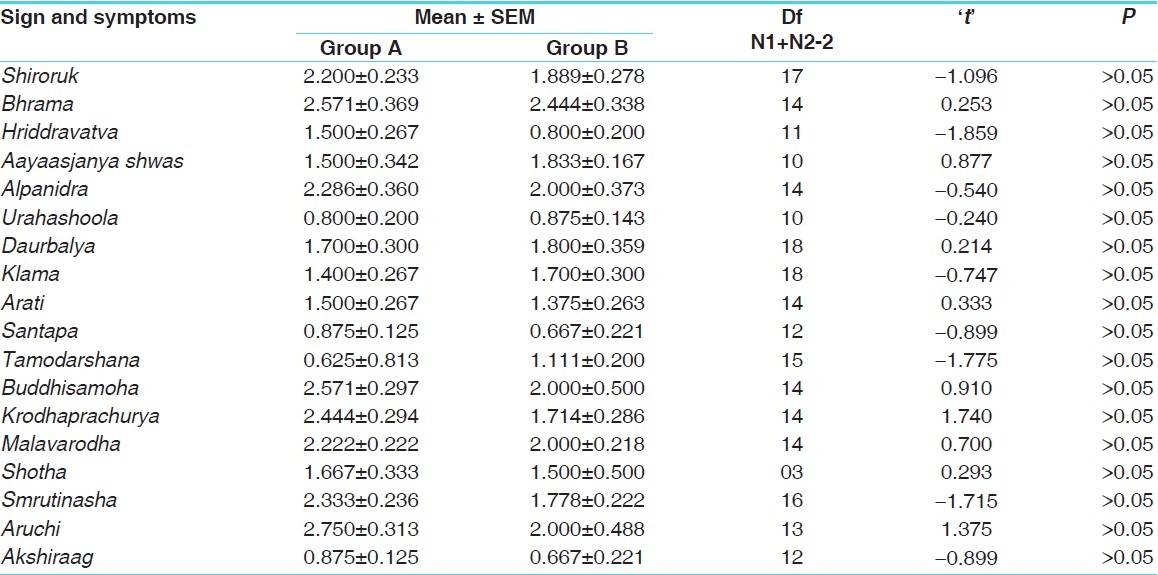
Table 9.
Comparison of results on blood pressure in both groups (by unpaired t-test)

During follow-up, blood pressure tended to rise after some week of discontinuation of treatment. Thus it is proposed that the medicines should be administered for longer duration.
References
- 1.Sharma Trivikram Atmaja Yadav., editor. Sutrasthana. 17. Vol. 20. Varanasi: Surbharti, Chaukhambha Publications; 2009. Agnivesha, Charaka Samhita, revised by Charaka and Dridhbala with ‘Ayurveda Dipika’ commentary by Chakrapanidatta; p. 115. [Google Scholar]
- 2.Naomi D, Gordon H. Hypertensive Vascular disease. In: Dennis L, Anthomy S, Dan L, Braunwald E, Stephen L, Larry J, editors. Harrisons’ principles of internal medicine. 17th ed. Vol. 2. New Delhi: Modern Publishers; 2005. p. 1468. [Google Scholar]
- 3.Sharma Trivikram Atmaja Yadav., editor. Sutrasthana. 13. Vol. 24. Varanasi: Surbharti, Chaukhambha Publications; 2009. Agnivesha, Charaka Samhita, revised by Charaka and Dridhbala with ‘Ayurveda Dipika’ commentary by Chakrapanidatta; p. 124. [Google Scholar]
- 4.Sharma Trivikram Atmaja Yadav., editor. Sutrasthana. 11. Vol. 20. Varanasi: Surbharti, Chaukhambha Publications; 2009. Agnivesha, Charaka Samhita, revised by Charaka and Dridhbala with ‘Ayurveda Dipika’ commentary by Chakrapanidatta; p. 113. [Google Scholar]
- 5.Acharya Kaviraja Ambikadutta Shaashtri., editor. Sharirasthana. 55. Vol. 4. Varanasi: Chaukhambha Surbharati Prakashana; 2005. Sushruta Samhita of Mahrshi Sushruta with ‘Ayurveda Tatva Sandipana’; p. 37. [Google Scholar]
- 6.Sharma Trivikram Atmaja Yadav., editor. Sutrasthana. 11. Vol. 20. Varanasi: Surbharti, Chaukhambha Publications; 2009. Agnivesha, Charaka Samhita, revised by Charaka and Dridhbala with ‘Ayurveda Dipika’ commentary by Chakrapanidatta; p. 113. [Google Scholar]
- 7.Sharma Trivikram Atmaja Yadav., editor. Sutrasthana. 11. Vol. 20. Varanasi: Surbharti, Chaukhambha Publications; 2009. Agnivesha, Charaka Samhita, revised by Charaka and Dridhbala with ‘Ayurveda Dipika’ commentary by Chakrapanidatta; p. 113. [Google Scholar]
- 8.Acharya Kaviraja Ambikadutta Shaashtri., editor. Sutrasthana. 12. Vol. 17. Varanasi: Chaukhambha Surbharati Prakashana; 2005. Sushruta Samhita of Mahrshi Sushruta with ‘Ayurveda Tatva Sandipana’; p. 72. [Google Scholar]
- 9.Naomi D, Gordon H. Hypertensive Vascular disease. In: Dennis L, Anthomy S, Dan L, Braunwald E, Stephen L, Larry J, editors. Harrisons’ principles of internal medicine. 17th ed. Vol. 2. New Delhi: Modern Publishers; 2005. p. 1469. [Google Scholar]
- 10.Sharma Trivikram Atmaja Yadav., editor. Sutrasthana. 15. Vol. 24. Varanasi: Surbharti, Chaukhambha Publications; 2009. Agnivesha, Charaka Samhita, revised by Charaka and Dridhbala with ‘Ayurveda Dipika’ commentary by Chakrapanidatta; p. 124. [Google Scholar]
- 11.Sharma Trivikram Atmaja Yadav., editor. Vimanasthana. 9. Vol. 2. Varanasi: Surbharti, Chaukhambha Publications; 2009. Agnivesha, Charaka Samhita, revised by Charaka and Dridhbala with ‘Ayurveda Dipika’ commentary by Chakrapanidatta; p. 238. [Google Scholar]
- 12.Aacharya Yadava ji Trikama ji., editor. Bhrama-Anidra- Unmadaadhikara. Vol. 19. Allahabad: Vaidhyanath Ayurveda Bhavana Limited; 2008. Siddha Yoga Sangrha; p. 101. [Google Scholar]
- 13.Mishra Brahamasankara, Vaishya Rupalalaji., editors. Varanasi: ChowkhambaSamskrita Series; 2007. Bhavaprakasha with Vidyotini Hindi Comm (1st Part) by Bhavamishra; p. 454. [Google Scholar]
- 14.Mishra Brahamasankara, Vaishya Rupalalaji., editors. Varanasi: ChowkhambaSamskrita Series; 2007. Bhavaprakasha with Vidyotini Hindi Comm (1st Part) by Bhavamishra; p. 461. [Google Scholar]
- 15.Sharma Trivikram Atmaja Yadav., editor. Chikitsasthana. 30. 1-3. Varanasi: Surbharti, Chaukhambha Publications; 2009. Agnivesha, Charaka Samhita, revised by Charaka and Dridhbala with ‘Ayurveda Dipika’ commentary by Chakrapanidatta; p. 385. [Google Scholar]
- 16.Mishra Brahamasankara, Vaishya Rupalalaji., editors. Varanasi: ChowkhambaSamskrita Series; 2007. Bhavaprakasha with Vidyotini Hindi Comm (1st Part) by Bhavamishra; p. 68. [Google Scholar]
- 17.Sharma PV. Dravyagunavigyana Vijnana. Varanasi: Chowkhamba Bharati Academy; 2005. p. 150. [Google Scholar]
- 18.Sharma PV. Dravyagunavigyana Vijnana. Varanasi: Chowkhamba Bharati Academy; 2005. p. 573. [Google Scholar]
- 19.Sharma PV. Dravyagunavigyana Vijnana. Varanasi: Chowkhamba Bharati Academy; 2005. p. 30. [Google Scholar]
- 20.Mishra Brahamasankara, Vaishya Rupalalaji., editors. Varanasi: ChowkhambaSamskrita Series; 2007. Bhavaprakasha with Vidyotini Hindi Comm (1st Part) by Bhavamishra; pp. 292–3. [Google Scholar]
- 21.Hix JK. Initial Evaluation of Blood Pressure. In: Brent M, Jan N, Lackland DT, editors. Hot Topics Hypertension. 1st ed. New Delhi: Elsevier a division of Reed Elsevier India Private Limited; 2004. p. 1. [Google Scholar]


